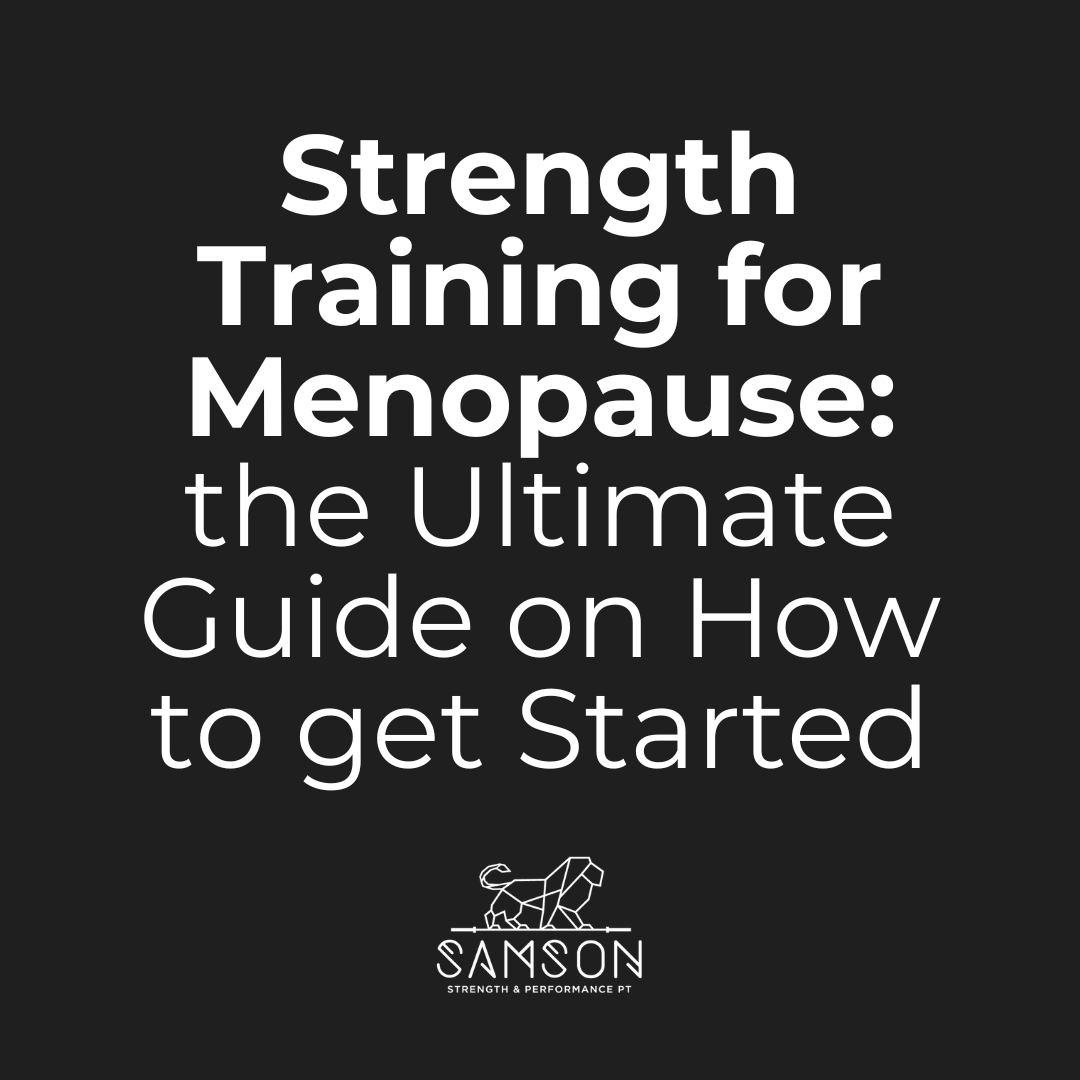Strength Training for Menopause: the Ultimate Guide on How to Get Started
Unless you live under a rock, you know that research is piling up showing the effects and benefits of strength training during perimenopause and menopause. Strength training has been shown to decrease symptoms of menopause, improve bone density and protect against sarcopenia (the gradual loss of muscle mass, strength, and function).
The tides are shifting and women are finally ready to start strength training in their 40s, 50s and 60s! The focus is shifting from getting as small as possible to getting as strong as possible and women are not afraid to take up space. The benefits of strength training are undeniable, but how do you get started when you are in your 40s, 50s, or 60s and you have no experience? Or you have only gone to group fitness classes that feel impersonal and focus on calories burned instead of weight lifted? I have begun to talk to so many women over 40 who are ready to learn to lift, but aren’t sure where to begin. They know they don’t want to go to a gym or join group classes, but they are not sure what to do at home. Here are some of the common questions I am asked surrounding strength training for menopause:
What are the best strength training exercises for menopause?
How many times a week should I strength train?
How many movements should I do?
How many sets and reps?
How do I structure my workouts?
In this blog, I will teach you how to structure your strength training for menopause. I will discuss the best exercises to focus on, the suggested frequency and duration of workouts, how to structure your plan, and what to include your workouts for the best results.
What are the best strength training exercises for menopause?
Here’s my list of the best strength training exercises for menopause:
Squat
Hinge
Upper Body Push
Upper Body Pull
Single Leg Variation
Carry
We will go into each of these and explore when you should do them, how often and how many sets and reps to get the most out of your strength training for menopause.
Squats:
Focused on the front of the thigh as a prime mover, but functionally includes the entire leg, core, back, and glutes. Squat variations can include: box squats, goblet squats, dumbbell front squats, cyclist squats, front squats, and back squats.
Hinge:
Focused on the back of the thigh as prime movers, but functionally includes the entire leg, core, back, and glutes. Hinge variations can include: good mornings, Romanian deadlifts, conventional deadlifts, sumo deadlifts, and back extensions.
Upper Body Push:
This can be either horizontal (bench press) or vertical (overhead press) and mainly focuses on chest, shoulders, and triceps.
Upper Body Pull:
This can be either horizontal (rows) or vertical (pull-ups or lat pull downs) and mainly focuses on upper back, lats, and biceps.
Single Leg Variations:
These are either squat or hinge biased and have an added bonus of working on balance.
Carries:
Carry variations typically work on grip and core stability, but can also incorporate shoulder stability, ankle stability, and endurance.
How many times a week should I strength train?
In a review article in the Journal of Mid-life Health concerning strength training for menopause, it was found that strength training only 2 times per week, but at 80% of total effort (80% of a 1 rep max) was sufficient stimulus for bone mineral density changes. This suggests that maximal load and NOT load frequency, is most relevant in bone mineral density changes.
In fact, anecdotally, I have seen women increase strength with only one session per week, but the effort level was high and the clients were motivated and had started with no experience. I have a client that went from deadlifting 13 pounds from an elevated surface to deadlifting 90 pounds from the ground for multiple reps within 10 months.
Honestly, I encourage women without any experience to begin with strength training 1-2 times per week. Consistency is key, so if you can only strength train one time per week, then start there. Depending on the schedule and preferences of the woman, I suggest lifting 2 times per week at a minimum and 3 times per week in an ideal world.
How many movements should I do?
If you take a look at my list of the best strength training exercises for menopause, ideally all of these movements would be incorporated into your routine weekly. Knowing this and the number of days per week you can commit to strength training, you would split the movements into 2 or 3 days. If you are only training 1 day per week to begin, you will still want to split the movements as if you are lifting 2 days and then alternate from week to week. Here’s what I mean…
My list of best strength training exercises for menopause can be broken down into 2 lower body movements, 2 upper body movements, and 2 accessory movements.
If you are breaking them into 2 days, it could look like this:
Day 1:
Squat
Upper Body Push
Single Leg Variation
Day 2:
Hinge
Upper Body Pull
Carry
If you are breaking them into 3 days, it could look like this:
Day 1:
Squat
Upper Body Push
Day 2:
Hinge
Upper Body Pull
Day 3:
Single Leg Variation
Carry
There are several ways to break this up, but in general, I like to pair a lower body exercise with an upper body exercise when the focus is longevity and strength training for menopause is all about longevity!
How many sets and reps?
As for sets and reps, I like to start my clients with 3 sets of anywhere between 8 and 15 reps. In the beginning, I like to focus on reps of 15 to dial in the motor coordination and because I find many of my mid-life clients are not used to a higher output or near maximal loading. The higher repetitions focus on understanding the movement pattern, but are still within the strength building window.
As you get comfortable with pushing your efforts, reps can be lowered. In fact, one study found that only 3 sets of 8 reps was sufficient to increase bone mineral density, but these women were lifting at 80% of their one rep max, which means they were lifting heavy. Three sets of eight reps will not cut it if you aren’t focused on really pushing your output. Eighty percent should feel like you only have 2 more reps that you could squeeze out.
How do I structure my workouts?
I typically structure my workouts and workouts for my clients as follows:
General increase in blood flow: bike, run, dynamic warm ups
Specific warm up: rehab exercises, any movements or mobilizations that prime you for the main lift that day
Main lift - relatively heavy (this can depend on the rep scheme, how you feel that day, etc) with 1-2 minutes of rest between sets
Accessory movements (if you are efficient and have time left after main lifts)
Cooldown stretches with deep breathing to down-regulate the nervous system
Following this outline will give you a great workout to focus on strength training for menopause and help to get you on your way to building muscle and stronger bones to help you stay active and happy for the rest of your life. It’s all about the quality of life as you age, because who wants to be stuck in the house throughout retirement? Let’s get strong to go out and adventure, see the world, stay active, and enjoy running around with grandkids!
Feeling stuck and want help?
If you’re finding it hard to start, finding an in-person program can make a big difference. At Samson Strength and Performance PT, we specialize in helping women find their strength with semi-private personal training led by a doctor of physical therapy. Dr. Delilah also offers online remote coaching options and tons of free resources in her newsletter. You can sign up for her newsletter below.
References:
Capel-Alcaraz AM, García-López H, Castro-Sánchez AM, Fernández-Sánchez M, Lara-Palomo IC. The Efficacy of Strength Exercises for Reducing the Symptoms of Menopause: A Systematic Review. Journal of Clinical Medicine. 2023; 12(2):548. https://doi.org/10.3390/jcm12020548
Hejazi K, Askari R, Hofmeister M. Effects of physical exercise on bone mineral density in older postmenopausal women: a systematic review and meta-analysis of randomized controlled trials. Arch Osteoporos. 2022 Jul 27;17(1):102. doi: 10.1007/s11657-022-01140-7. PMID: 35896850.
Mishra, Nalini; Mishra, V. N.1; Devanshi, 2. Exercise beyond menopause: Dos and Don’ts. Journal of Mid-life Health 2(2):p 51-56, Jul–Dec 2011. | DOI: 10.4103/0976-7800.92524

